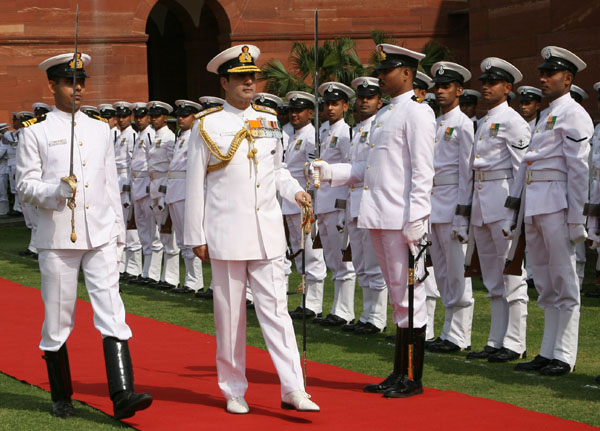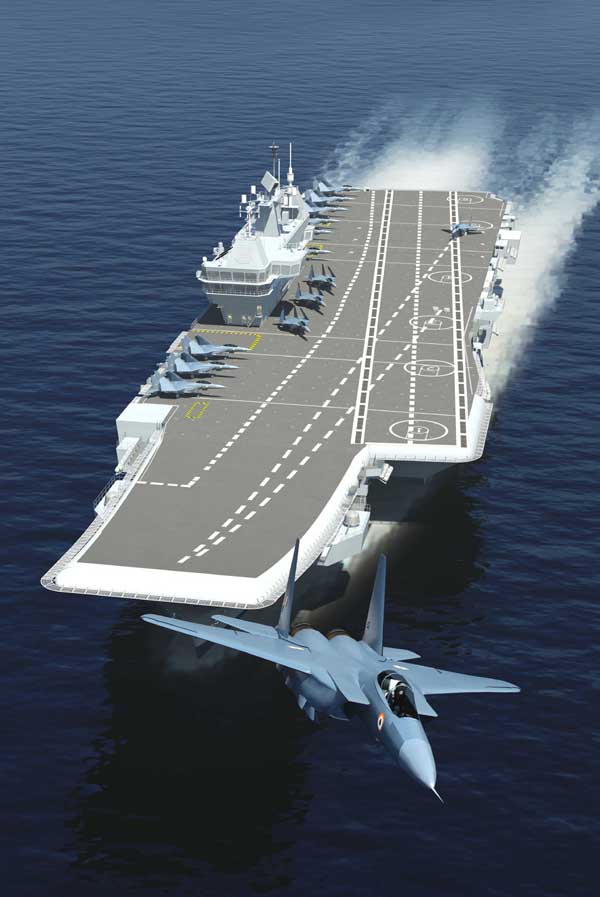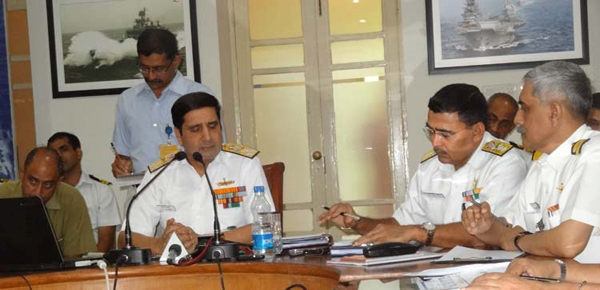|
Meanwhile by end-2013, the Navy should get delivery of the much delayed but modernised INS Vikramaditya – aka
Admiral Gorshkov – which is now undergoing final trials in Russia. (Vikramaditya means brave as the sun and Vikrant
means victorious in Sanskrit, the ancient Indian language).
Vice Admiral Robin Dhowan, Vice Chief of the Naval Staff, laid
out some plans of the Navy at a press conference
here August 1, saying that the Navy wanted a permanent
presence of one Carrier Battle Group each on India’s
western and eastern seaboards. A third aircraft
carrier, IAC-2, is necessary to fill in for periodic
maintenance and upgrade schedules. About 75 per
cent of the structural work on IAC-I, particularly
its underwater sections, is already complete,
he disclosed.

However, nothing has been finalised yet about the IAC-2, and all options are open.
He observed: A detailed study was on about the "size, type of aircraft and their launch and recovery systems, propulsion"
and that “we are also considering nuclear propulsion. All options are being studied. No final decision has been taken (yet).”
Unmanned aircraft, like the Northrop Grumman’s X-47B which recently did a landing on the carrier deck by itself, is also
among the options if available.
Naval sources said that nuclear or turbine propulsion, the type of aircraft including 5th generation, weapons and sensors,
the size of the carrier, steam propelled or electromagnetic launch of aircraft from the carrier, all these and other options
were before the Naval Headquarters and it would be some time before these specs are frozen and forwarded to the Ministry of
Defence for approval.. Information from various components and systems manufacturers is being sought and studied.

Reports so far indicate that the IAC-2 will have 60,000 tonnes or more displacement. In any case, from design to
construction and integration of onboard systems, an aircraft carrier is a time-intensive project.
The Navy celebrated the Diamond Jubilee of its naval aviation this year, and according to Vice Admiral Dhowan, 2013 is
also being anointed as the Year of Maritime Security through Self-reliance. He described the indigenous construction of
IAC-I aka INS Vikrant at the Cochin Shipyard Limited (CSL) as “the Crowning Glory” for the Indian Navy, pointing out that
the men in white have the responsibility to protect India’s maritime interests.
About 90 per cent of India ’s trade by volume and 70 per cent by value is conducted through the seas.
It may be kept in mind that the Navy is just about to launch
any time its indigenous nuclear propelled, nuclear
armed (SSBN) submarine, the INS Arihant (meaning
destroyer of enemies in Sanskrit).

But IAC-I is designed for MiG- 29Ks and India
’s Light Combat Aircraft (LCA) whose naval variant
is being developed by HAL.
For IAC-II, the LCA should be there but the possibility of MiG- 29Ks is remote as newer aircraft technologies are fast emerging
and like any force, the Navy would like to have futuristic systems.
The effort though is rightly to have as much indigenous components as possible, developed either through local R&D or transfer
of technology (ToT) from outside. Dhowan described the IAC-I as “truly a watershed milestone in India’s shipbuilding endeavors.”
Notably, the Indian Navy has a design bureau, inherited from the Royal Navy, and it has commendable achievements to its credit.
Of the 46 warships and submarines under construction for the Navy, 45 are being built in India.

As the country’s maiden carrier project, the venture has had inherent challenges. But with experience at hand now, the Navy is
looking forward to designing and building other large ships like the INS Jalashwa, the former USS Trenton (LPD 14) acquired from
Washington in 2007. The key in each case, observed the distinguished officer, will be on state-of-the-art futuristic technologies.
In the case of IAC-I for instance, the indigenous content is approximately 50 per cent. The special high tensile steel required
for the carrier has been developed by DMRL (Defence Metallurgical Research Laboratory) of DRDO (the Ministry of Defence’s Defence
Research & Development Organisation) and the public sector SAIL (Steel Authority of India). Navy officers went out of the way to praise the support and speedy action provided by civil service officers in the Ministries of Defence and Shipping, who are otherwise blamed for routine procedural delays. "In this case the teamwork from all quarters, the minister included, is exceptional," a senior officer told India Strategic.
The emphasis now is on developing or acquiring advanced Electronic Warfare capabilities for indigenous production.
As tradition has it, the wife of a dignitary – in this case Mrs Elizabeth Antony, wife of Defence Minister AK Antony – will launch
the ship and invoke blessings while Navy Chief Admiral DK Joshi will wish the crew Fair Winds and Following Seas, the global nautical
expression for good luck.
INS Vikrant is powered by four LM2500 gas turbine engines, sourced from the US GE company. These engines are also being used now
on warships like the INS Shivalik stealth, multi-role frigates. The GE LM2500 engine is derived from GE CF6 aircraft engine.
Admiral Dhowan also gave a surprise by saying that INS Viraat (or giant in Sanskrit) will continue to be in service till 2018,
till INS Vikrant is delivered. Decommissioning of this old aircraft carrier has been decided upon a few times but apparently, due to
the delay in the delivery of INS Vikramaditya from Russia, it has been put on upgrades to oxygenate it again and again.
INS Viraat – erstwhile HMS Hermes – has Harriers and helicopters on board.
As for INS Vikramaditya and INS Vikrant, both will have a complement of about 25 combat aircraft and helicopters each. There
could be a maximum of 20 MiG-29Ks or LCAs on board depending upon missions.

Each carrier battle group will include warships, submarines, support vessels, electronic surveillance from Boeing P-8I Long
Range Maritime Reconnaissance (LRMR) aircraft and satellites, secure communications, satellite connectivity, and Long Range Surface-
to-Air Missiles (LR SAMs) for which DRDO and Israel Aerospace Industries (IAI) have a joint development venture. The funding for this
missile, called Barak 8, is largely provided from the Indian Navy’s budget, and it will be first fitted on the P 15A Kolkata class
destroyers being launched from 2014 onwards. The missile, to be test-fired shortly, is likely to be made in the private sector, whose
participation is being encouraged now by the Government.
Pointing out that INS Vikrant will also have a Close-in Weapon System (CIWS) for point defence, in this case the AK 630 fast
firing Gatling gun, based on a Soviet/Russian system and made by India’s Ordnance Factory Board (OFB), Dhowan said that the LR SAMs
would also be fitted on board INS Vikramaditya but after it has been delivered to India. Russia is also providing the aircraft control
systems.
The Indian Navy, which has ordered 45 MiG-29Ks and received nearly half of them, plans to board the first squadron on INS
Vikramaditya as soon as it is in the Indian waters following delivery before December 4, the Indian Navy Day.
The MiG-29s will also continue to operate from INS Hansa, the naval base in Goa, where simulators and a 14-degree ski jump has
been erected to train pilots. INS Vikrant will also have a 14-degree ski jump to facilitate takeoff.
The production of the 37,500 tonne IAC-I began in 2006 and its keel was laid in 2009. Italy’s Fincantieri has assisted in
designing its propulsion, which should enable the carrier to achieve a speed of 28 knots (approx 52 kmph).
Significantly, US Northrop Grumman has offered the shipboard Hawkeye 2D battle management and electronic warfare aircraft to
the Navy while recently, General Atomics, which has innovated the new generation Electro Magnetic Aircraft Launch System (EMALS)
for the US Navy, has offered the same to India for its future carrier/s. EMALS is replacing the steam catapult propulsion
traditionally used to launch aircraft from the limited runways available on aircraft carriers.
The US Sikorsky is in the race to supply different types of helicopters including the Black Hawks with production in India
if the numbers ordered are adequate to justify that.
India’s Vikramaditya and Vikrant are using the ski jumps, the same system which the Navy has on INS Viraat and the decommissioned,
older INS Vikrant, the Indian Navy’s first aircraft carrier acquired from Britain in 1957. This Majestic class ship, formerly HMS
Hercules, was phased out in 1997 and turned into a naval museum in Mumbai (Bombay).

In the naval traditions, names of ships are passed to successor vessels.
Vice Admiral Dhowan, a highly distinguished officer with varied experience including of commanding missile ships, said that the
new INS Vikrant is 260 metre in length, 60 metre in breadth and able to accommodate a mix of 25 aircraft and helicopters as well as
a crew of about 1,450. It will generate 24 MW of power, enough to light a small township and have sufficient fresh water and air
conditioning facilities sourced indigenously.
The carrier has two runways, one of 206 metre and the other of 145 metre.
It has 2,500 km of cables, 70 km of pipes, 2,300 compartments, and two takeoff runways and a landing strip with three arrester
wires as part of the STOBAR (Short Takeoff But Arrested Recovery) capability. Once operational, it will have a crew of about 1,450.
One laudable achievement of the design team and engineers is the construction of the massive gear box which will transmit the power from the four engines to the carrier's shafts and screws.
With the launch of INS Vikrant, India is the fifth country in the world to build aircraft carriers of around 40,000 tonnes,
the others being the US, Russia, France and Britain.
China has done a remarkable refit job on Liaoning, the nearly
55,000 ton Soviet Varyag it acquired from Ukraine
through a Hong Kong based travel company for a
hotel and casino project for a small amount of
$20 million in 1998. The PLAN (People’s Liberation
Army - Navy) is now operating shipboard combat
aircraft from it. But China is yet to formally
announce its indigenous aircraft carrier building
projects, although there should be no doubt that
work should have already commenced.
Italy commissioned the 30,000 ton Cavour in 2008, but it is supposed to carry only vertical takeoff aircraft like the Harrier
and helicopters. As the Harrier is being phased out, Italy has ordered the Lockheed Martin F-35B Lightning II aircraft, which are
yet to be delivered.
Notably, in vertical takeoff, aircraft have to spend a lot of power thereby reducing their weapon load. But then, in future, the
bombs will weigh less and carry more destructive power. Boeing is already working on small diameter weapons.
The availability of such systems and the choice of aircraft, manned and unmanned, in the coming years will determine how big a
future Indian carrier would be. The role defined though will stay the same: Protect India’s Maritime Interests and ensure safety
from terrorists.
|